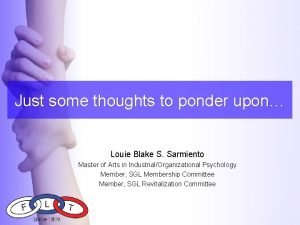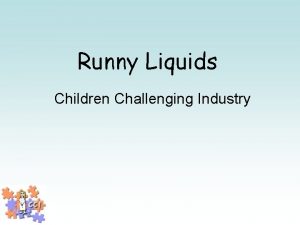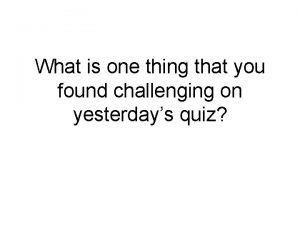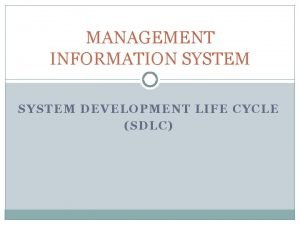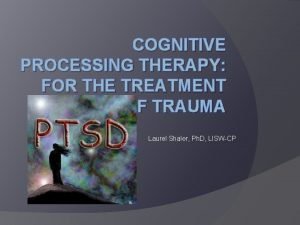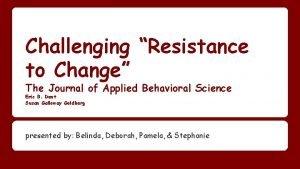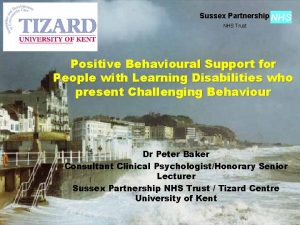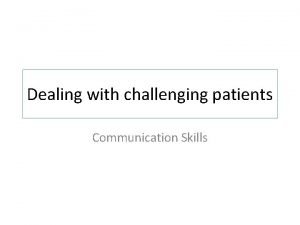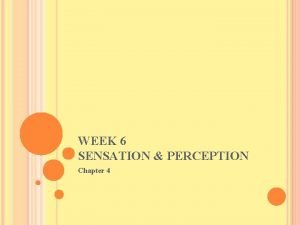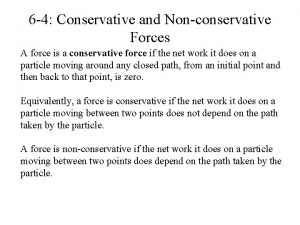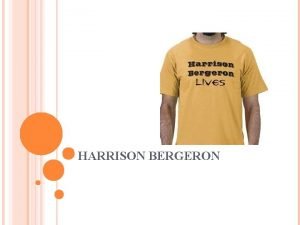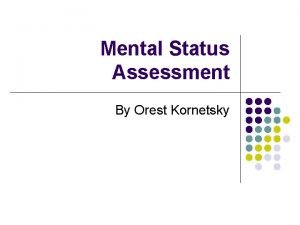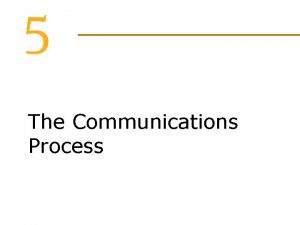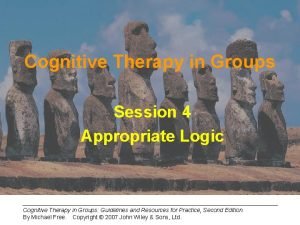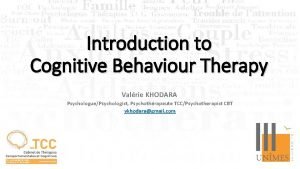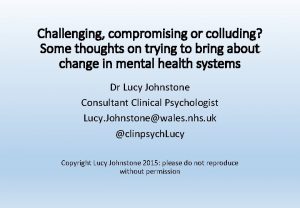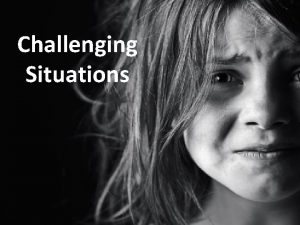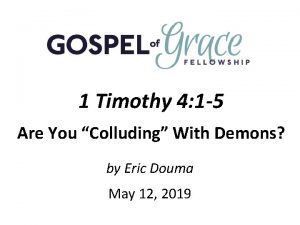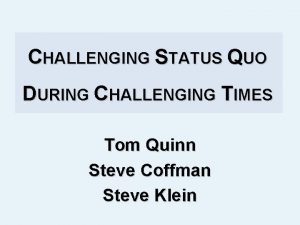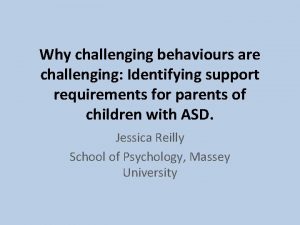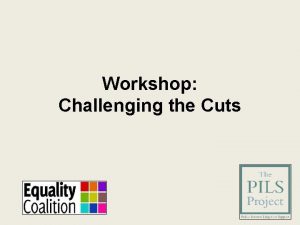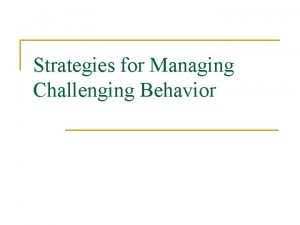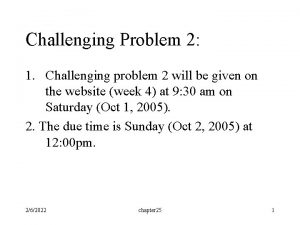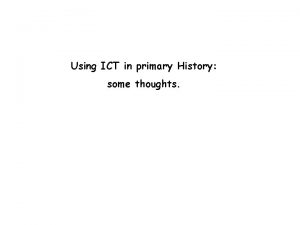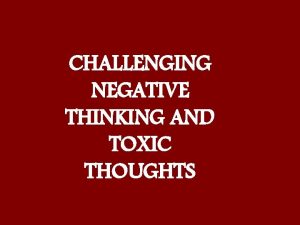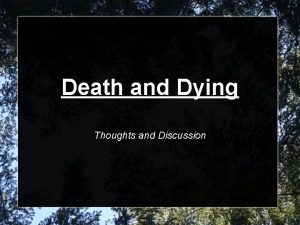Challenging compromising or colluding Some thoughts on trying













































- Slides: 45

Challenging, compromising or colluding? Some thoughts on trying to bring about change in mental health systems Dr Lucy Johnstone Consultant Clinical Psychologist Lucy. Johnstone@wales. nhs. uk @clinpsych. Lucy Copyright Lucy Johnstone 2015: please do not reproduce without permission

Outline of talk • The wider context: threats to prevailing paradigm in psychiatry • The ethical challenge for professionals working within existing systems • Some small examples of bringing about a degree of change…. .

‘Western psychiatry is in crisis’ ‘Western psychiatry is in crisis. ’ ‘…. . the simplistic and imposed application of…. reductionist science’ which can ‘encroach on basic human rights. ’ (Mental Health Europe 2013, a large umbrella organisation representing both professionals and service users. ) ‘Is psychiatry dying? Crisis and critique in contemporary psychiatry’ Morgan, Social Theory and Health, 2015, 13, 2, 141 -161 www. madinamerica. com – for everything you need to know about critiques and alternatives in mental health Plus Phil Hickey’s blog

‘If it becomes apparent that the information obtained by testing disease theories is incoherent, we may eventually jettison particular disease constructs…. The disease constructs in psychiatry may be approaching this point. ’ (Bebbington: Psychological Medicine October 2014) ’The disease model of schizophrenia is not supported by the evidence and obscures the real function of psychiatric care’ (Moncrieff and Middleton: 2015 Curr Opinion Psychiatry) ‘Some observers have questioned whether the psychiatrist is an endangered species…Urgent action is required… to ensure the future of psychiatry as a profession’ (Oyebode and Humphrys, British Journal of Psychiatry, 2011)

The DSM 5 debacle ‘There is no reason to believe that DSM-5 is safe or scientifically sound…. . The science simply isn’t there now……A research dead end. ’ Professor Allen Frances, Chair of DSM IV Task Force Dr Steven Hyman, former NIMH director : DSM is 'totally wrong, an absolute scientific nightmare. ' Dr Thomas Insel, current director of NIMH: 'Patients…. . deserve better…. . The weakness is its lack of validity. ’ Dr David Kupfer, chair of the DSM-5 committee: ‘We've been telling patients for several decades that we are waiting for biomarkers. We're still waiting. ’ From now on, ‘NIMH will be re-orienting its research away from DSM categories’ (Insel, 2013. )

‘There is no definition of a mental disorder. I mean, you just can’t define it. It’s bullshit’ (Dr Allen Frances) http: //www. wired. com/magazine/2010/12/ff_dsmv/ Without a valid classification system, psychiatry would become ‘…. . something very hard to justify or defend – a medical specialty that does not treat medical illnesses’ (Breggin 1993)

In ‘Anatomy of an epidemic’ (2010) award-winning US science journalist Robert Whitaker presents compelling evidence that all psychiatric drugs increase disability over the long term. ‘This is the story of a medical puzzle… It tells of a hidden epidemic that is diminishing the lives of millions of Americans, including a rapidly increasing number of children. The epidemic has grown in size and scope over the past five decades and now disables 850 adults and 250 children every day…Now here is the puzzle. As a society we have come to understand that psychiatry has made great progress in treating mental illness over the past 50 years…. In 2007 we spent $25 billion on anti depressants and anti psychotics…. As the psychopharmacology revolution has unfolded, the number of disabled mentally ill has skyrocketed. ’ Maudsley debate May 2015: ‘This house believes that long-term use of psychiatric medication does more harm than good. ’ See BMJ editorial 2015, 349

‘First do no harm. ’ Ethics column in Clinical Psychology Forum September 2014 ‘It’s hard to imagine such a record of harms could be tolerated in any other branch of healthcare, and it is hard to imagine how an ethical perspective can tolerate our use of the failed medical model paradigm in mental health any longer. It’s time to reach beyond diagnostic dependence. ’ Dr Sami Timimi, co-chair of Critical Psychiatry Network ‘…Questions about how we respond to human suffering are not simply ones of science or evidence, though that may be a part of it. They are ultimately moral, ethical and political issues on which we all need to take a stand. ’ Johnstone 2006 in ‘Critical psychiatry: The limits of madness’ ed Duncan Double, Palgrave Macmillan

Challenge, compromise or collude, as a professional within services? There are no simple answers. Individual professionals will choose different solutions at different times and in different situations. A degree of collusion is probably unavoidable. Example of IAPT: ‘Do psychologists really want to get involved in… “therapy” as one means of cajoling the unwell and the impoverished into jobs that, for many, will be poorly paid, unrewarding and, indeed, unhealthy? ’

Perhaps the only guiding principle is that we should be honest about these ethical dilemmas rather than pretending we are engaging in an unproblematic, evidence-based, humane attempt to ‘treat mental illnesses. ’ ‘Silence or denial of our involvement is no less a political act than explicit political action…. . The choice we have to make…is not between involvement and non-involvement, but between awareness of our involvement and denial’ (Kidner, 2007) But all of this depends on being aware of the dilemmas in the first place…and it isn’t easy, welcome or comfortable to raise these issues in any setting, clinical, educational or public.

‘Regarding my experience of the critical perspective of the course, I can only compare it to psychology boot camp…Within months I had moved into the “unsafe uncertainty” box where I didn’t believe things I used to and was questioning ideas and “facts” that hadn’t even occurred to me to query. Honestly, I can’t say that was a nice place to be. A necessary place definitely, but not a comfortable one…The course has taught me how to question, evaluate, take perspectives, listen and say “I don’t know”…As we approach the end, I feel secure in what I believe psychology to be capable of…I am incredibly proud to be associated with a course which values the critical consumption of research, ideas and “truth. ”’ (Johnstone 2010, Clinical Psychology Forum)

Battle of Ideas festival, London, 17 -18 October 2015 ‘Stigmatising mental health: are you mad? ’ ‘Part of the problem is that as a society, we seem to be so bad at finding a middle ground between ‘You have a medical illness and therefore your distress is real and no one is to blame for it’ and ‘Your difficulties are imaginary or someone’s fault, and you ought to pull yourself together. ’ As a clinician, it is my job to find this mid point – to acknowledge that the distress is real and terrible and no one intended it to be that way, AND to help someone put together the personal story that makes it understandable – which also means recovery is possible. Once we are honest and brave enough to admit that people with a MH diagnosis really are just like us – all of us – 4 in 4 of us, not just 1 in 4 of us – there is a real chance that stigma can be vanquished. ’

So…what are we actually dealing with in MH services? ‘An overwhelming amount of evidence tells us that…. we cannot afford to ignore the context of social inequality and injustice in our work, for scientific as well as ethical reasons. This will inevitable also involve us in challenging, not colluding with, some of the core tenets of biomedical psychiatry. In this way we will be facing ethical dilemmas head on, wherever we work, and fulfilling our moral and professional responsibilities. ’ Chapter on ‘The clinical psychologist’ in Mental Health Ethics: The human context’ ed Phil Barker, Routledge 2011 ‘Levels of distress among communities need to be understood less in terms of individual pathology and more as a response to relative deprivation and social injustice’ (WHO, 2009. ) ‘If Britain became as equal as the four most equal societies (Japan, Norway, Sweden and Finland), mental illness might be more than halved’ (Wilkinson and Pickett, 2009. )

The ‘ACE’ (Adverse Childhood Experiences) studies ‘The most important studies you’ve never heard of’ 17, 421 participants, 15 year follow-up, over 50 papers 10 types of childhood adversity (sexual, verbal or physical abuse; parent with diagnosis of ‘mental illness’, domestic violence, family member in prison, loss of a parent; emotional or physical neglect). Strong graded relationship between ACE scores and mental and physical illhealth, behavioural and social problems.

Higher ACE scores predict greater incidence of depression, suicide, ‘psychosis’, PTSD, drug use, criminal behaviour, heart disease, cancer, STDs, lung disease, liver disease, smoking, obesity, diabetes, poor educational and work performance, homelessness, prostitution, unemployment, and early death. ACEs act in a cumulative and synergistic way to cause ‘complex adult psychopathology. ’ www. acestoohigh. com

Some ideas for bringing about change in existing services • • Policy documents Promoting alternative models of distress Promoting new clinical practices Listening to people’s stories …. and as part of this…joining with and supporting service users/survivors at every opportunity…. . grassroots change is always the most powerful

Bristol trainees’ list • • • Building respectful team relationships Finding allies Being part of the team Building influence (if not power) Getting your hands dirty Challenging ideas not people or professions Being ‘curious’ Circulating articles, contributing to journal clubs Inviting outside speakers Offering, not imposing, alternative perspectives Remembering that a single conversation can change lives Looking after yourself!

DCP/BPS consultation response 2011 ‘Clients and the general public are negatively affected by the continued and continuous medicalisation of their natural and normal responses to their experiences; responses which undoubtedly have distressing consequences which demand helping responses, but which do not reflect illnesses so much as normal individual variation…. …. . The putative diagnoses presented in DSM-V are clearly based largely on social norms, with 'symptoms' that all rely on subjective judgments, with few confirmatory physical 'signs' or evidence of biological causation. The criteria are not value-free, but rather reflect current normative social expectations…. . … [taxonomic] systems such as this are based on identifying problems as located within individuals. This misses the relational context of problems and the undeniable social causation of many such problems. ’

DCP Position Statement on Classification 2013 ‘The DCP is of the view that it is timely and appropriate to affirm publically that the current classification system as outlined in DSM and ICD, in respect of the functional psychiatric diagnoses, has significant conceptual and empirical limitations and there is thus a need for a paradigm shift in classification in relation to these diagnoses, towards one which is no longer based on a “disease” model. ’ International and national coverage (eg The Observer 12. 5. 13 ‘Medicine’s big new battleground’)

Mixed reactions, as you might expect…… ‘The groups… who are actually proud to identify themselves as “anti-psychiatry”…They are, to my mind, misguided and misleading idealogues and self-promoters who are spreading scientific anarchy’ (Jeffrey Leiberman, former APA President, 20. 5. 13) ‘…extremist posturing by the BPS’ (Dr Allen Frances ) ‘One UK psychologist used the DSM launch to say on twitter “All psychiatric diagnosis is wrong” and not be shouted down – instead being given the platform of the Today programme, our morning agenda setting current affairs show – to air her views’ (Simon Wessely, RCP Chair, 6. 6. 13)

Supporting statements from Division of Educational Psychology, Critical Psychiatry Network, Hearing Voices Network England, Psychological Society of Ireland, Psychosis and Complex Mental Health Faculty, and others 4 pages of supporting letters in July’s The Psychologist, including one with 220 signatures. The Critical Psychiatry Network (200 UK psychiatrists) ‘The DSM is incapable of capturing the full range of experiences of distress in the way that narrative formulation can’ 2. 5. 13

Shared theme of recent DCP documents ‘Services should not insist that all service users see their problems as an “illness” and take medication’ (‘Understanding Bipolar disorder’ 2010) http: //shop. bps. org. uk/understanding-bipolar-disorder. html ‘Understanding Psychosis’ 2014 Free download from www. understandingpsychosis. net ‘Hearing voices or feeling paranoid are common experiences which can often be a reaction to trauma, abuse or deprivation. Calling them symptoms of mental illness, psychosis or schizophrenia is only one way of thinking about them, with advantages and disadvantages’ (p. 6)

Reactions to ‘Understanding psychosis’: ‘…exploits, disrespects, silences and marginalises service users. . Understanding Psychosis should be seen as a cruel hoax perpetrated against more typical severely disturbed mental health service users, their family, and policymakers’ ‘And while the psychologists lobby for a greater piece of the treatment pie…. slanting to their own "narrow professional selfinterests" …. the suffering of those with the most serious of mental health problems and issues -- real illnesses -- continues. ’ A fierce debate at https: //www. psychologytoday. com/blog/psychunseen/201503/psychosis-sucks

The trauma-informed model The emerging ‘trauma-informed’ model recognises the causal role of trauma and adversity in all human systems organisations (psychiatric, addictions, criminal justice, social care. ) It also acknowledges that many interventions may be retraumatising. Psychiatric ‘symptoms’ are in fact evolved survival strategies – adaptive at the time but they have outlived their usefulness A 3 stage approach (education and stabilisation; trauma processing; reconnecting to one’s life) underpins all therapeutic work (Dillon, Johnstone and Longden 2012) See summary at www. asca. org. au

• Childhood trauma, abuse and neglect is strongly linked to all psychiatric breakdown, including ‘psychosis’ • Evidence of a dose-dependent relationship between the severity, number, and number of types of traumatic episodes, and the likelihood of psychosis (People abused as children are 9. 3 times more likely to develop psychosis; risk rises to 48 times for the severest abuse (Janssen et al, 2004); people who have experienced 3 kinds of abuse were 18 times more likely to be psychotic; 5 types of abuse = 193 times more likely (Shevlin et al, 2007. ) • The causal relationship holds in prospective studies and after controlling for gender, ethnicity, education, substance abuse, etc. • The content of delusions is often closely related to actual experiences of abuse (Read et al, 2005)

An emerging evidence base from neuroscience and attachment theory shows how trauma creates a state of high arousal when stems from the overwhelming of coping mechanisms in response to extreme stress. ‘Complex’ trauma is cumulative, repetitive and interpersonally generated. Early interactions with caregivers are crucial in later relationship formation and emotional regulation. Trauma memories are processed differently, unintegrated from autobiographical narrative, and not ‘labelled’ with time and place. Dissociative responses to extreme stress, when it is not possible to fight or flee, include hearing voices, panic attacks, mood swings, unusual beliefs, flashbacks and so on. ‘Symptoms’ are best understood as survival strategies, necessary at the time but not adaptive in present circumstances. A trauma-informed environment seeks to minimise triggering and establish safety across all areas of service delivery, on a cross-diagnostic basis (including addictions. )

Good practice guidelines on the use of psychological formulation 2011

Jane is 17. She left school last year and now works in a shop. She has a good relationship with her mother but says she does not like her stepfather. After some difficulties with her manager, Jane has started to find work too stressful and is now off sick. She reports hearing a hostile and critical voice. She is now very distressed and too terrified to leave the house. Diagnosis: Psychosis/schizophrenia

You had a happy childhood until your father died when you were aged 8. As a child, you felt very responsible for your mother's happiness, and pushed your own grief away. Later your mother remarried and when your stepfather started to abuse you, you did not feel able to confide in anyone or risk the break-up of the marriage. You got a job in a shop, but you found it increasingly hard to deal with your boss, whose bullying ways reminded you of your stepfather. You took time off sick, but long days at home made it hard to push your buried feelings aside any more. One day you started to hear a male voice telling you that you were dirty and evil. This seemed to express how the abuse made you feel, and it also reminded you of things that your stepfather said to you. You found day-to-day life increasingly difficult as past events caught up with you and many feelings came to the surface. Despite this you have many strengths, including intelligence, determination and selfawareness, and you recognise the need to re-visit some of the unresolved feelings from the past.

Principles of best practice formulation Best practice formulation …. ‘Is not premised on a functional psychiatric diagnosis (eg schizophrenia, personality disorder)’ (p. 20) ‘Interventions will be ineffective if wider causal factors are located at an individual level, thus pathologising the service user and increasing their sense of hopelessness’ p. 20 • Have a critical awareness of the wider societal context within which formulating takes place, even if this dimension is not explicitly included in every formulation p. 20

Trauma-informed formulation • Considers the possible role of trauma and abuse • Considers possible role of services in compounding the difficulties ‘…. . the potentially traumatising effects of medical and psychiatric interventions’ (p. 14) Trauma-informed formulations can help us to make sense of people’s distress, to bear witness to survivors’ stories, and to develop a shared framework for recovery

The meta-message of a best practice psychological formulation is: ‘You are experiencing a normal reaction to abnormal circumstances’ ‘Anyone else who had been through the same events might well have ended up reacting in the same way’ ‘Symptoms’ are in fact survival strategies – essential at the time but they have outlived their usefulness A simple but radical and empowering message in the context of the dominance of the biomedical model of emotional distress


‘If the authors of the diagnostic manuals are admitting that psychiatric diagnoses are not supported by evidence, then no one should be forced to accept them. If many mental health workers are openly questioning diagnosis and saying we need a different and better system, then service users and carers should be allowed to do so too. This book is about choice. It is about giving people the information to make up their own minds, and exploring alternatives for those who wish to do so. ’

Team formulation - a powerful way of changing cultures In which a team or group of professionals develop a shared psychobiosocial formulation about a service user 1. Regular meeting for most or all team members, at which a formulation is co-constructed 2. Parallel process of formulating with the service user when appropriate, which informs and feeds into the team formulation Ideally……. 3. Formulation integrated into every part of the service, from initial assessment onwards ‘Using formulation in teams’ chapter in Johnstone and Dallos (2013)

Simple format: - What is the current question or ‘stuck point’? - Is the background correct/complete? - Develop a shared formulation - Draw out implications for intervention - Facilitator writes it up and circulates for agreement - Added to the records - Review as necessary in future meetings Inform and include service user (meet them beforehand, feed back afterwards, develop parallel formulation to feed into staff version in a recursive process)

• A non-diagnostic, trauma-informed training and intervention package for all staff (Emotional Focused Formulation Approach) is integrated into secondary Adult Mental Health in Southampton (Isabel Clarke’s work. ) • Sussex Partnership Trust has introduced formulation into all stages of the care pathway from assessment onwards in its Adult and Older Adult service • Older Adult service in Tees Esk and Wear which uses individual and team formulation in 10 community teams and 4 wards. All 400 staff have mandatory training in formulation. It is integrated into standard processes and records. • Northumberland, Tyne and Wear AMH inpatient services • Team formulation meetings running in all parts of the AMH service in Cwm Taf Health Board, South Wales (See November issue of Clinical Psychology Forum)

‘Taking formulation into a wider setting can be a powerful way of shifting cultures towards more psychosocial perspectives. ’ New Ways of Working in Teams (Onyett 2007) ‘The formulation model quickly becomes familiar to everyone in the team, and this fosters a shared psychological language’ (Lake 2008) ‘A good formulation can be a powerful systemic intervention, changing the meaning of the client’s subjective experiences and the team’s thinking’ (Kennedy et al 2003. ) ‘Using formulations may help in shifting staff culture’ (Summers 2006. )

Some examples from Cwm Taf Health Board, South Wales Poor mental and physical health is recognised as a cause and consequence of social deprivation and inequality across Cwm Taf, in the South Wales Valleys area, which is the most deprived Health Board in Wales. 13% of the population is in contact with mental health services – the highest proportion in Wales. Localities like Merthyr Tydfil are recognised as amongst the most deprived in the UK, on a par with some areas of Glasgow.

Regular team formulation meetings now running in: • All four CMHTS (Taf Ely, Rhondda, Cynon, Merthyr) • Both AO teams • Rehab service • Inpatient wards Training for local social care teams who have also introduce this practice Cardiff psychology services are implementing the team formulation model in their health board

Initial evaluation of team formulation work in Cwm Taf 100% of the participants felt that the meetings had helped to develop a shared team understanding of a client’s problems, strengths and difficulties; draw on the knowledge and skills from different professional backgrounds; generate new ideas about working with the client; develop an intervention plan; and improve risk management. (Hollingworth and Johnstone, 2014)

Team formulation has paved the way for further developments CPD events on trauma-informed services Sign-up by management to a trauma-informed model Training in trauma-informed work to all teams and staff groups A ‘Stabilisation Pack’ of psychoeducation about the impact of trauma on the mind and body, plus emotional regulation skills and strategies, used by all MDT members • Sexual abuse survivor groups for women – now running in all 4 localities (Taf Ely, Rhondda, Merthyr, Cynon) • • General shifts in language, understanding and awareness

Listening to people’s stories – the radical alternative to psychiatric diagnosis. Something all professionals can do. Instead of asking ‘What’s wrong with you? ’ we need to ask ‘What’s happened to you? ’ …and instead of giving people a diagnosis, we need to listen to their stories.

‘People who have survived atrocities often tell their stories in a highly emotional, contradictory, and fragmented manner which undermines their credibility and thereby serves the twin imperatives of truth-telling and secrecy…. . Witnesses as well as victims are subject to the dialectic of trauma. It is difficult for an observer to remain clearheaded and calm, to see more than a few fragments of the picture at one time, to retain all the pieces, and to fit them together. It is even more difficult to find a language that conveys fully and persuasively what one has seen…. The knowledge of horrible events periodically intrudes into public awareness but is rarely retained for long…. Clinicians know the privileged moment of insight when repressed ideas, feelings, and memories surface into consciousness…. Victims who have been silenced begin to reveal their secrets…. Survivors challenge us to reconnect fragments, to reconstruct history, to make meaning of their present symptoms in the light of past events. ’ Judith Herman (1992) ‘Trauma and recovery’

Resources Johnstone, L (2000) (2 nd edn) Users and abusers of psychiatry: a critical look at psychiatric practice. Routledge Johnstone, L and Dallos, R (2013) ‘Formulation in psychology and psychotherapy: making sense of people’s problems. ’ 2 nd edn Routledge ‘Medicine’s big new battle ground: does mental illness really exist? ’ The Observer 12. 5. 13 http: //www. theguardian. com/society/2013/may/12/medicine-dsm 5 -row-does-mental-illnessexist Eleanor Longden, formerly diagnosed with schizophrenia and now a researcher and campaigner, gives an inspiring TED talk at http: //www. ted. com/talks/eleanor_longden_the_voices_in_my_head. html An equally inspiring talk by Jacqui Dillon, chair of the Hearing Voices Network in England http: //www. youtube. com/watch? v=JHz. Hliy 5 ye. Q Talk by two psychologists from the Salomons course on ‘Is life a disease? ’ http: //www. youtube. com/watch? v=XQx. ORht. Hiow Blog on www. madinamerica. com/author/ljohnstone by Lucy Johnstone critiquing diagnosis and promoting formulation as an alternative, plus many other articles on the www. madinamerica. com site Johnstone, L Diagnosis and formulation (2013) In (eds) J Cromby, D Harper and P Reavey Understanding mental health and distress: Beyond abnormal psychology Palgrave Macmillan
 Avoiding turtle conflict management
Avoiding turtle conflict management I am not my thoughts
I am not my thoughts Thoughts to ponder upon
Thoughts to ponder upon Challenging behaviour scenarios
Challenging behaviour scenarios Children challenging industry
Children challenging industry What i found challenging
What i found challenging Preliminary investigation
Preliminary investigation Examples of challenge
Examples of challenge Periodic sentences
Periodic sentences Abc worksheet cpt
Abc worksheet cpt Exciting, boring, dangerous, safe, interesting, challenging
Exciting, boring, dangerous, safe, interesting, challenging System development life cycle phases
System development life cycle phases Challenging resistance to change
Challenging resistance to change Zfinancial
Zfinancial Dealing with challenging patients
Dealing with challenging patients Contact forces
Contact forces They say sometimes you win some
They say sometimes you win some Fire and ice diamante poem
Fire and ice diamante poem God when you choose to leave mountains unmovable
God when you choose to leave mountains unmovable Some say the world will end in fire some say in ice
Some say the world will end in fire some say in ice Cakecountable or uncountable
Cakecountable or uncountable Some may trust in horses
Some may trust in horses Where did columbus land in america
Where did columbus land in america Skill 24 adjectives and adverbs
Skill 24 adjectives and adverbs “we are trying to prevent a world war, not start one”
“we are trying to prevent a world war, not start one” Dimitri and linda are trying to learn a new routine
Dimitri and linda are trying to learn a new routine A motorcyclist is trying to leap across the canyon
A motorcyclist is trying to leap across the canyon Frandec company manufactures
Frandec company manufactures What is microfiction
What is microfiction Stop trying to justify yourself
Stop trying to justify yourself What was ida tarbell trying to change
What was ida tarbell trying to change Todd is trying to quit cheating
Todd is trying to quit cheating Why was ben milam trying to rally the texan troops?
Why was ben milam trying to rally the texan troops? 31-syllable japanese poem
31-syllable japanese poem What is mukraking
What is mukraking Mary is trying hard in school this semester her father said
Mary is trying hard in school this semester her father said Harrison bergeron handicap activity
Harrison bergeron handicap activity Characteristic patterns
Characteristic patterns Psalms 94 17
Psalms 94 17 Abstract thought
Abstract thought Source oriented thoughts
Source oriented thoughts Examples of thoughts
Examples of thoughts Woman's mission
Woman's mission Our life is what our thoughts make it
Our life is what our thoughts make it The art of expressing one's thoughts in verse
The art of expressing one's thoughts in verse Automatic thoughts examples
Automatic thoughts examples


